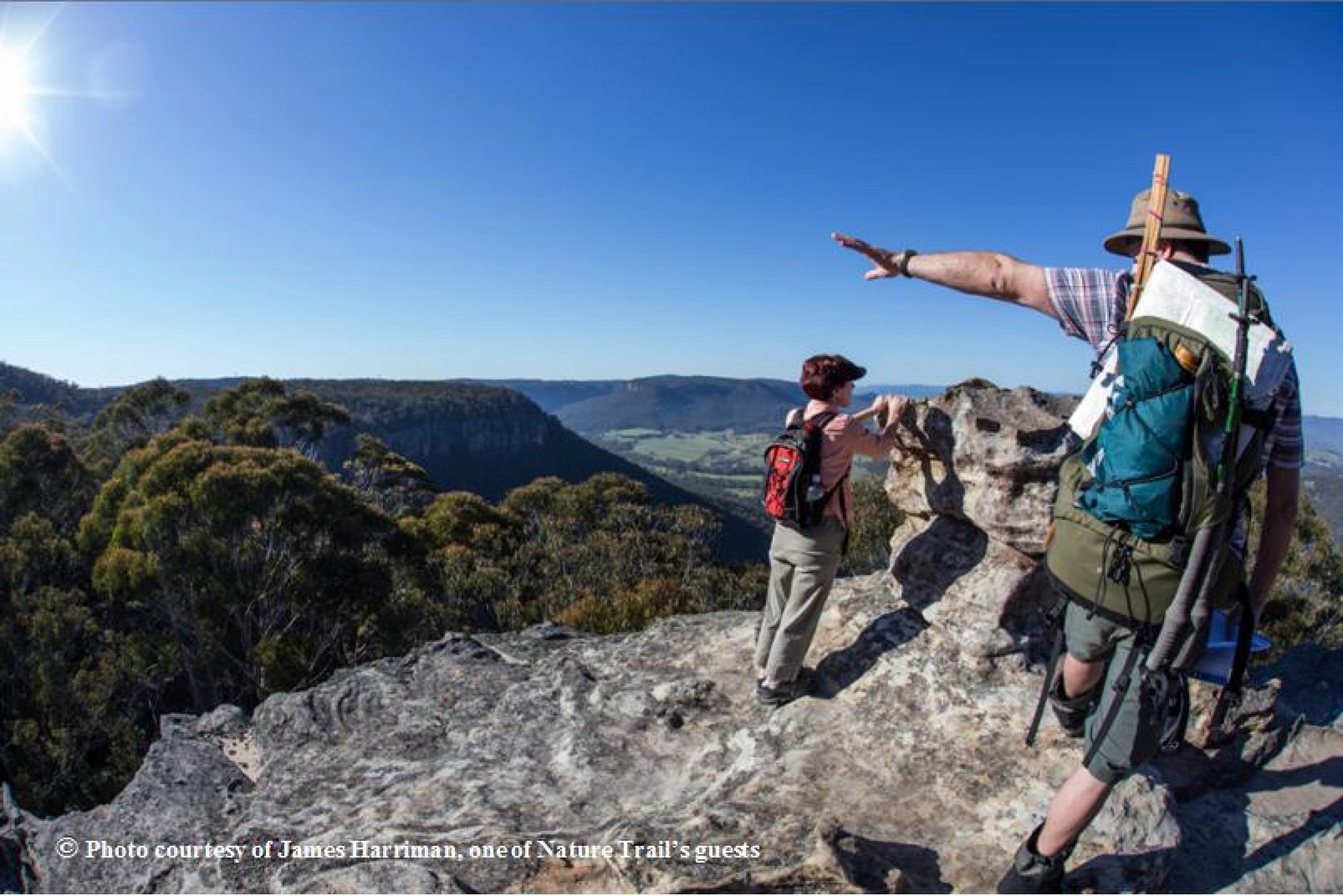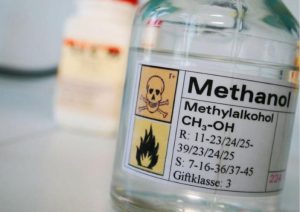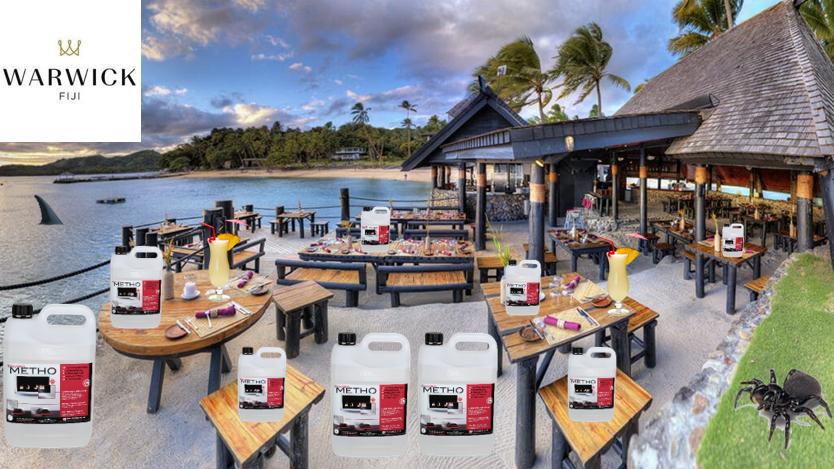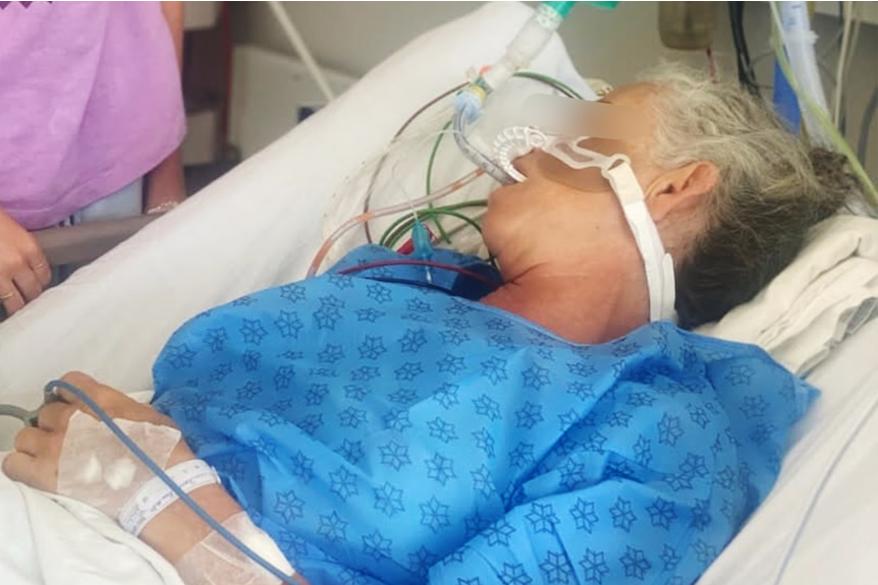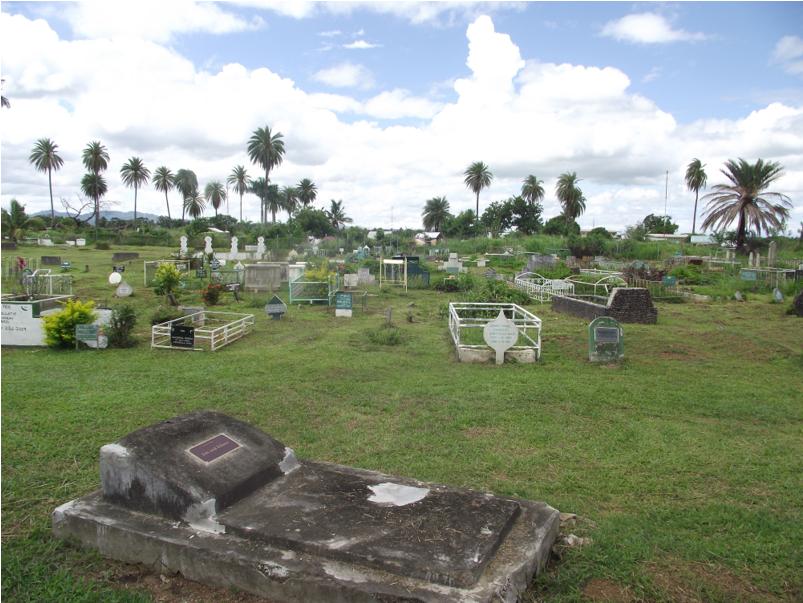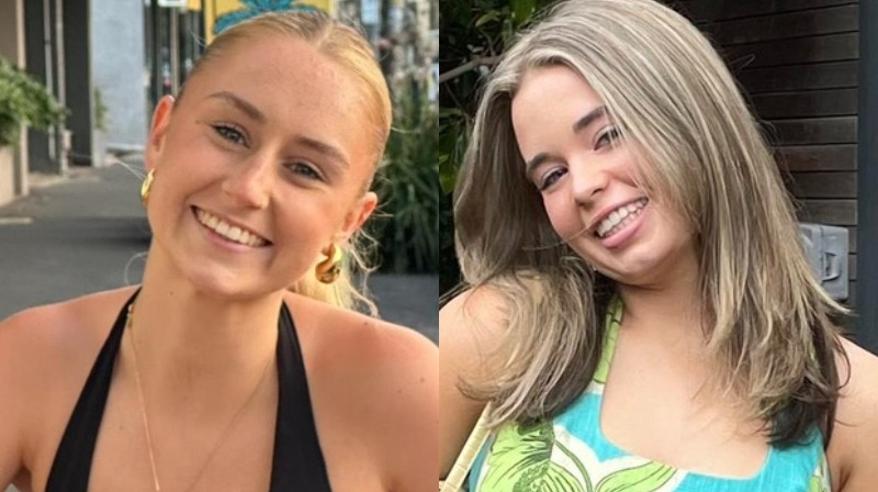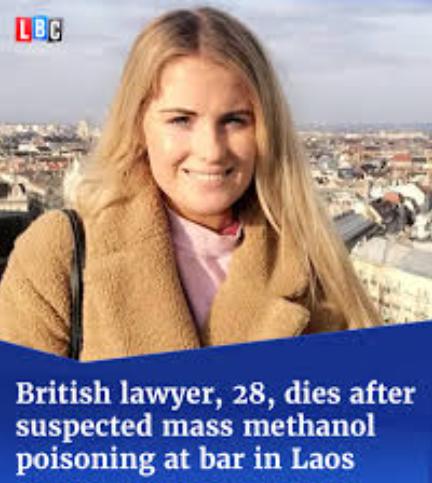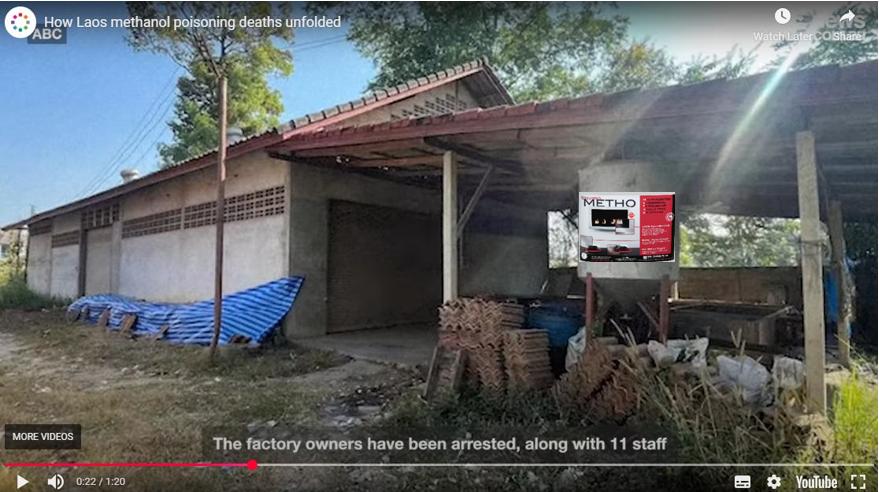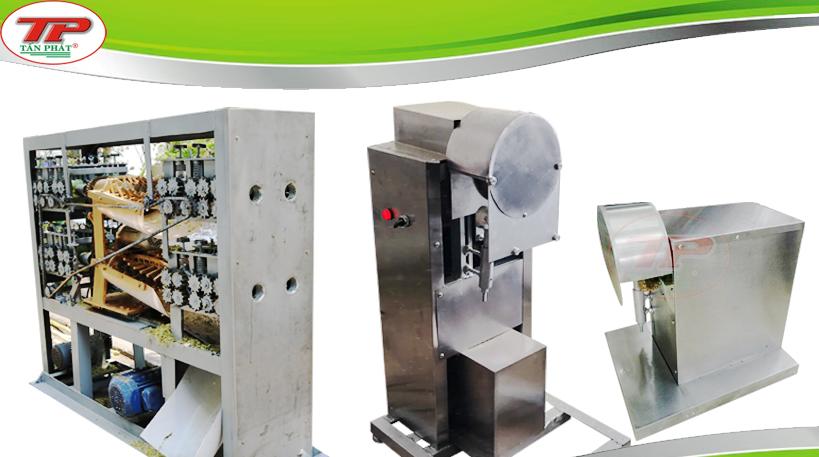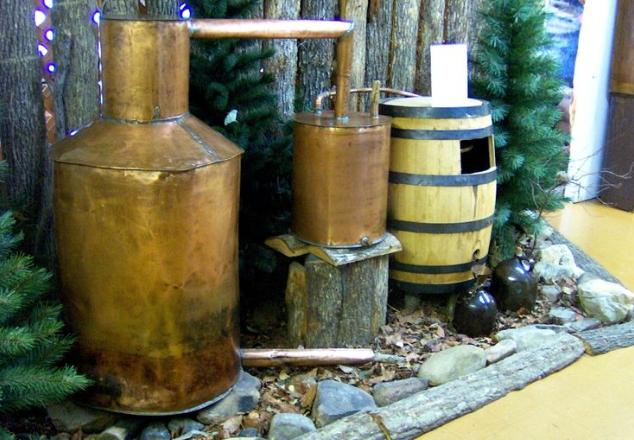Methanol Party Tourism – one sip and you’re in a box home

Fancy a really, really, really cheap holiday overseas? Well, you may return in a box.
Whereas a litre bottle of reasonable quality white spirit like white rum might sell for around $60 in a liquor store in Australia.
Whereas, totally unrelated four litres of lethal mentholated spirits (looking the same clear liquid) sells for around just $20 at most hardware stores. But it ain’t for drinking, it stinks, and nor is formaldehyde for drinking (used to preserve animal specimens and embalming bodies) as well as formic acid (the same toxin in bee stings).
So, beware upon ingestion of the tiniest amount of methanol (the equivalent volume of just 1/2 an egg cup – or two sips, or just 25ml, both the formaldehyde and formic acid become chemically ‘converted’ and seriously risk killing you.
Yet, in many dodgy cheap foreign countries, mentholated spirits (‘metho’) continues to be sold and made available even cheaper or for free at legal bars! Dodgy criminal tourist operators overseas have been switching the likes of calling it vodka over the bar when serving party cocktail drinks to unsuspecting foreign tourists.
For instance, Fiji, Bali, Thailand and Laos have made the news recently as holiday death traps for foreign tourists engaging in ‘party mode’ when adventuring in backwardly run countries.
Fiji Methanol Spiking:
In December 2024, Australian mother Susan (58) with her daughter (18) flew to Fiji for a relaxing Christmas holiday together, staying at the ‘Warwick Fiji’ resort on the south ‘Coral Coast’ tourist resorts stretch of the main island, Viti Levu.
Their choice of stay was enticed by a bargain offer of 30% off their stay.

Susan asked not to be identified to protect her 18-year-old daughter who had been traumatised by the incident in Fiji. (ABC News: Supplied)
Then on the last day in Fiji, Susan’s daughter shouted them both each a popular pina colada cocktails drink from the Warwick Fiji’s poolside bar. It would have seemed par for the course for the last afternoon relaxing by the resort’s pool.
But in hindsight a very bad idea! Both pina coladas were laced with metho, not rum. A decision that would change both of their lives.
When Susan’s daughter tried one, she told her mother it tasted really weird. Susan said: “So I had two sips of the cocktail, and said, ‘Hmmm, you know, not sure.'”
She remembers her daughter buying the drink, tasting it, then Susan going snorkelling.
Susan:
“By the time I got out, [my daughter] found me, and she was hysterical, she was having like an allergic-type reaction (anaphylactic symptoms) to imbibing a sip of the (Fiji Pina Colada). “Her hands were shaking, she said her mouth was really tingly, and when she drank water it tasted like sand.”
Susan remembers the day in question clearly up until the time she then suddenly collapsed and fell into a coma. “I was going downhill very fast”. Susan also started to get the shakes and what she described as “the same mouth feel”. “I could feel I was starting to lose control,” she said.
They were both taken to the local clinic, then to the Lautoka Hospital (a more than 2 hours drive away). In five hours, Susan was unconscious.
“There were eight beds in there and pretty much all of the beds became full of Warwick guests. I could see in the room that other people were going to various states of seizures and other experiences. I was going downhill very fast. I was shaking violently and I could see the other medical staff were busy with the other patients, and I was like, ‘Don’t forget about me,’ and that’s all I remember. That’s the last time I was conscious.”
Susan, along with another one of the guests, was ‘intubated’ (lungs and blood stream connected with life-saving medical tube support).
Specialists later told her that her heart went into “stress cardio myopathy” due to what was happening with her brain following the seizures, and her heart function went down to 25 per cent, with fluid build-up around her heart.
Susan (below) spent the next three days in an induced coma.
Mother Susan was then flown on an emergency Medevac mission out of Nadi (Fiji) by Air Ambulance Fiji – a dedicated 4-hour direct flight to Brisbane (Australia). Here she spent a further week in the intensive care unit (ICU) on medical life-support at a Brisbane hospital, likely The Royal Brisbane and Women’s Hospital.
Susan:
“I’ve spent the last five months trying to recover. “Without [the help we got], I would be dead.” “We were poisoned”. “We’re frustrated because we’ve got no real evidence of what happened to us. That’s the most frustrating thing. [And we feel] that’s been blatantly done, a cover-up.”
Susan says she has spent the past five months recovering from the incident. Susan, a financial accounts manager, has not been able to work since the incident and, because of her seizures, her drivers licence has been cancelled. Now, as she continues to recover, she’s searching for answers.
It seems that so were another five tourists who also also imbibing the Warwick’s metho pina coladas at the resort’s same pool bar.
Pina Colada (Puerto Rican Recipe)
Shake 1 1/2 ounces golden or añejo rum with 1 ounce coconut cream and 1 ounce pineapple juice, and pouring it over ice. A spritz of lime peel over the cocktail is a perfect finishing touch. Enjoy!
Pina Colada (Fijian Cheap Hybrid Version)
Shake 1 1/2 ounces metho (80 proof) with 1 ounce coconut cream and 1 ounce pineapple juice, and pouring it over ice. A spritz of barringtonia asiatica (Fiji fish poison tree flower) over the cocktail is a perfect finishing touch to the death sentence.

Two Fiji Pina Coladas ordered by the reporting journalist (but obviously just for photo purposes, but wisely not imbibed) as prepared by the same bartender at the Warwick Hotel. Fiji Pina Coladas are locally known not as a pick me ups, but as a “carry me outs“.
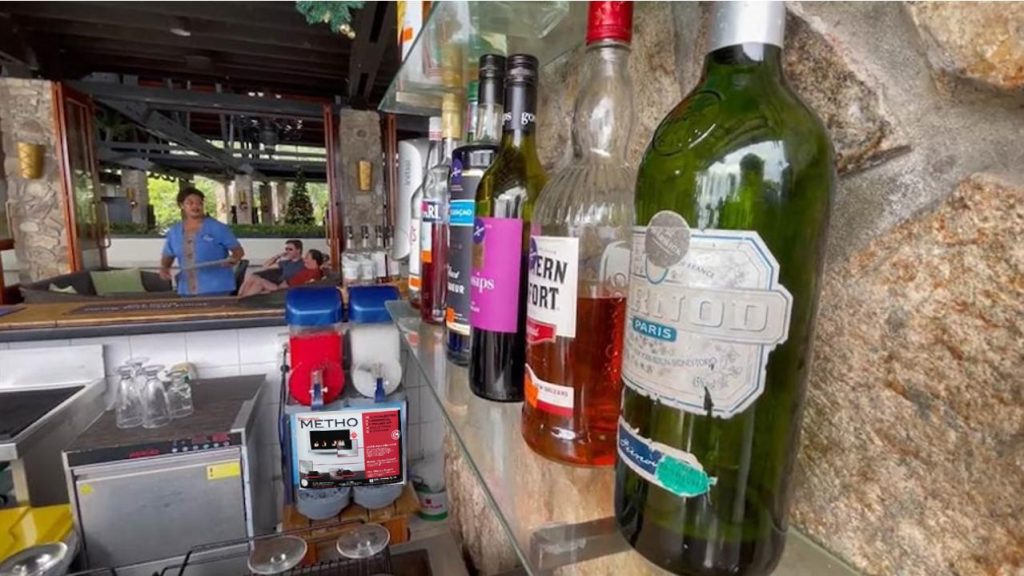
The very same bar at Warwick Resort Fiji, where the seven guests who became ill were served Metho instead of the expensive imported white rum.
And more than five months on, it is still unclear what actually caused the seven tourists, including Susan, to suffer such a horrific reaction on that Saturday afternoon in December.
No-one has been interviewed about the incident until now.
Susan, who spoke to the ABC on the condition she not be identified so she could protect her daughter who was “traumatised” after watching the events unfold in Fiji, said she was crystal clear about what happened to her.
Susan:
“I believe that the alcohol we consumed was tainted and that we were poisoned. The only commonality between the seven victims was that we were all in the pool, and we all drank a pina colada within an hour of each other.”
Warwick Resort Fiji human resources manager (Indian) Nitin Goundar (image below) reckons the Fiji Pina Colada is “a normal menu beverage for all the guests”.
But Susan believes there has been a “cover-up”, in part to protect Fiji’s multi-million-dollar tourism industry.
After initially agreeing to an interview, the Warwick Fiji resort later declined the ABC’s request. It also declined to answer any questions.
At the time, it was feared that the seven tourists in Fiji might have also consumed methanol. Susan said the group of seven guests involved in the incident were speaking to a lawyer to explore action against the resort, which she said had failed in its duty of care.
Susan:
“We want some sort of acceptance of responsibility, probably from the Warwick, foremost, but also from the Fiji authorities who we feel have tried to shut down or underplay what happened.”

Susan and her daughter returned from Fiji back to Australia certainly not the way they had intended, but just lucky to be alive. Yet both remain traumatised for life. Fiji was supposed to be a “safe” family holiday destination for bloody Christ sake!
Suing the owners of the Warwick Fiji could however be problematic and costly.
The Warwick Fiji, is part of the global (40 property) hospitality group Warwick Hotels and Resorts, which is owned and controlled by Hong Kong born Richard Chiu (Chiu Lǐchá dé), president and founder. The primary global headquarters in primarily located at 75 Avenue des Champs-Élysées, Paris, France 75008.
The Warwick brand and logo were hijacked by buyout, usurping this English medieval heritage tradition (Warwick Castle – think William the Conqueror, 1068).
Warwick’s Chiu simply likes 100% control [^Read More].
Four days after the incident, Fiji’s government released the results of its tests of the drinks, declaring there was “no methanol” found. And in March, three months after the incident — and after multiple delays — it revealed the results of blood and urine samples sent to New Zealand, declaring again there was “no methanol”.
Yet documents obtained by the ABC media reveal a critical omission: while the government claimed the New Zealand results showed nothing harmful, they failed to disclose that the sample from the sickest patient, Susan, was never sent for independent testing.
In a brief press conference on Tuesday evening, Fiji’s Tourism Minister Viliame Gavoka said the initial toxicology report from testing the drinks found “no illicit substances or methanol”. Yet, Fijian Health Secretary James Tudravu, who joined the deputy prime minister at the press conference, did not reveal a cause of the illnesses that left the seven people hospitalised, saying “toxicology was continuing”.
Laos Methanol Spiking:
The revelation came less than a month after the deaths of Melbourne teenagers Holly Bowles and Bianca Jones from methanol poisoning after drinking tainted alcohol at the Nana Backpackers Hostel in the riverside tourist town of Vang Vieng in Laos about two hours north of the capital Vientiane in November 2024.
Holly Bowles (19), right, was confirmed to have died on Friday, a day after British lawyer Simone White and Australian Bianca Jones (left). Her friend Bianca Jones, also 19, and British lawyer Simone White, 28, below) from south-east London, were confirmed to have died on Thursday.
Sadly, in addition at the time an unnamed America man and two Danish women, aged 19 and 20, are also among the victims of the suspected poisoning, believed to be connected to bootleg alcohol (backyard methanol).
This tragedy brings to a total of six foreign tourists who have died after apparently drinking tainted alcohol in this same backpacker hostel in Laos.
The Nana Backpacker Hostel – where the Australian teenagers were staying – has said it gave out free shots to around 100 guests the previous evening.
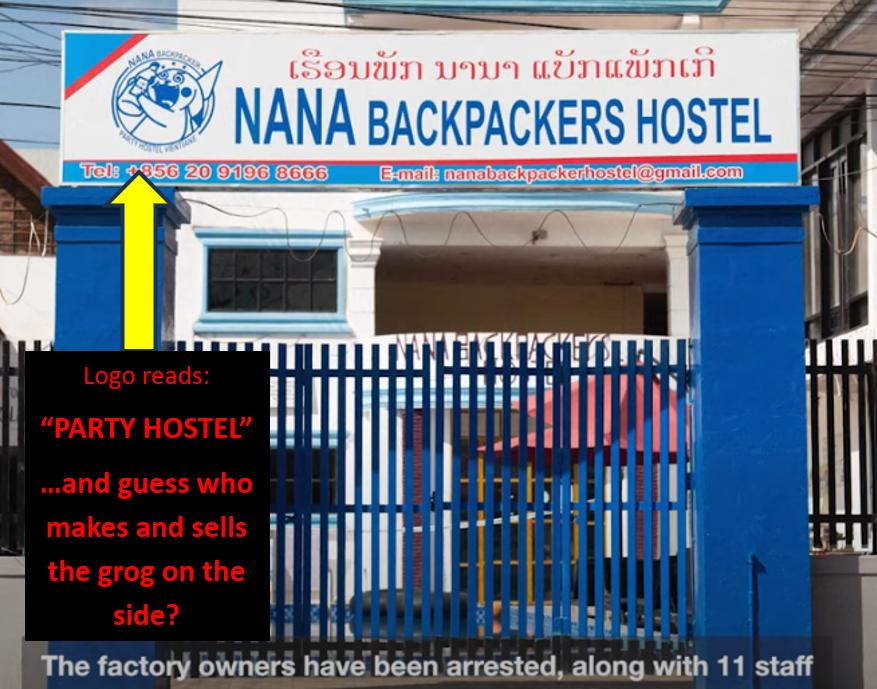
A place to avoid: Laos town ‘Vang Vieng’ may be sold as a popular backpacking town in Laos…but expect to return home in a coffin box!
Medical specialists say drinking as little as 25 millilitres of methanol can be fatal, but it is sometimes added to drinks because it is cheaper than alcohol.
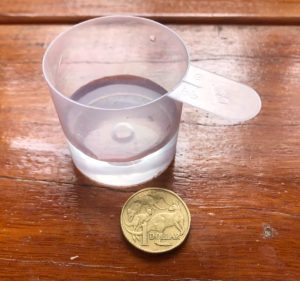
The volume of 25ml in comparison to the dimensions of an Australian $1 coin. Think of methanol as formaldehyde.
Christer Hogstrand, a professor of molecular ecotoxicology at King’s College London points out that it is also “not uncommon in home-distilled alcohol“.
Hogstrand:
“Methanol is like the alcohol in our drinks – colourless and odourless – but its impact on humans can be deadly. It has a different carbon atom structure which completely changes how humans process it in the body, leading to these potentially fatal consequences.”
A key cultural problem in poor South-East Asian countries like Indonesia, Laos and Thailand (popular with particularly young western tourists who like to party) is the trendy cocktails using unknown ingredients, such as ‘Lao Lao’, backyard ‘Hooch’ and ‘Mojito’ shots.
Vang Vieng has had an underground party scene going way back into the early 2000s and has become a key staging post on what is known to backpackers as the banana pancake trail, which typically starts in Bangkok’s Khao San Road and loops through Thailand, Cambodia, Vietnam and Laos.
Backyard methanol is made from liquid extracts of ripe plants sugars, then distilled in a still. Seems it doesn’t take much…
Professor of clinical pharmacology at Sydney University, Nicholas Buckley, says bad batches frequently poison many unsuspecting tourists every year. Regions with weak regulations and relatively unsophisticated healthcare systems are worst hit, particularly countries in South-East Asia, South Asia, the Middle East and parts of Africa and Eastern Europe. He says the initial symptoms are indistinguishable from other illnesses common to travellers: nausea, vomiting and abdominal pain.
Prof. Buckley:
“Methanol converts to formaldehyde (preserves specimens), which is a really toxic chemical used to sterilise things, and then formic acid (bee sting liquid), which is the toxin that ants make to scare things away. So two quite toxic chemicals. That step from methanol, which is just a bit like ethanol, to those two toxic compounds is blocked by ethanol – or fomepizole IF it’s available. It is injected into a vein. You want to get the treatment in as soon as possible,” he said. “Once someone goes into a coma, things are looking pretty bad.”
The chemistry: Methanol is converted to formaldehyde via alcohol dehydrogenase and formaldehyde is converted to formic acid (formate) via aldehyde dehydrogenase. The conversion to formate via ALDH proceeds completely, with no detectable formaldehyde remaining.
[SOURCE: ^https://en.wikipedia.org/wiki/Methanol_toxicity]
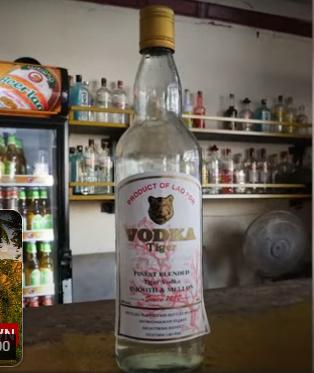
Such dodgy legal concoctions cooked up in backyard shed then get presented at bars to unsuspecting young holiday makers at super cheap prices (like $1 shots), like this banned Tiger Vodka. It’s voluntary euthanasia, Laos style.
And just because it’s poured from a bottle with a Johnny Walker or Jim Beam labels, that doesn’t mean it’s going to be safe.
These two methanol spiking instances are not “one offs”.
FURTHER STORIES TBA…
‘Don’t let it be your best friend that dies from methanol poisoning’
25 April 2025
Jack Gray & Jared Evitts
BBC Newsbeat
Bethany (left) met her friend Simone in Laos to explore the country in south-east Asia
The best friend of a woman who died from methanol poisoning on holiday has called on the government to do more to educate teenagers in schools about the dangers of drinking alcohol abroad.
Bethany Clarke was travelling in Laos in south-east Asia with childhood friend Simone White when they drank free shots they were offered in a hostel in November.
The following day, they both became unwell and initially thought they had food poisoning.
But, a few days later, 28-year-old Simone died in hospital.
The Department for Education have been contacted for a comment about Bethany’s petition.
Simone, who was from Orpington in south-east London, and Bethany planned to stay in Cambodia for just under two weeks, and spend four days in Laos.
They fell ill after drinking six vodka shots served to them at the Nana Backpackers hostel in traveller hotspot Vang Vieng.
Five other tourists also died after drinking at the hostel.
Their drinks are thought to have contained methanol – a deadly substance often found in bootleg alcohol.
Medical specialists say drinking as little as 25ml of methanol can be fatal, but it is sometimes added to drinks because it is cheaper than alcohol.
But Bethany, 28, tells BBC Newsbeat they didn’t even realise anything was wrong until the next day.
“This all happened on the fourth day of the trip. We did the tubing that day and that was good,” she says.
“It’s difficult to obviously describe the timeline. I think when I realised it was all going wrong was when we were on the kayaks for a trip we were doing the following morning. So just over 12 hours on.
“I guess that was when me and Simone were flat on the back of these kayaks, not being able to use our arms. We were just literally staring up into space.
“That was a moment where I thought I really don’t understand what’s happening to us. It just seemed like I was just having to accept my fate.”
Bethany and Simone fell ill while kayaking the next day – 12 hours after drinking the vodka shots
Bethany says even when they tried to get help, it took them a while to be treated for methanol poisoning and they had to search for information about it themselves.
“The doctors kept saying it was food poisoning, which obviously didn’t help with trying to treat what was going on,” she says.
“This is when our other friends said ‘let’s get to a private hospital’. In the ambulance on the way there our friend mentioned to the paramedic ‘could it be methanol poisoning?’ He’d done a little bit of research on his phone.
“They rushed Simone off to have dialysis straight away and said to me ‘look can you just sign these forms and we’ll do our best to save her life?’
“And yeah, they did their best.”
Bethany says the group trusted the hostel because the reviews were good but she’s now urging others to be careful.
“We didn’t think we were doing anything stupid, but obviously now I do feel like I should have known more.
“The advice is from me ‘steer clear, drink beer’. Look up the symptoms, be mindful about where you’re drinking.
“Just don’t let it be your best friend that dies from methanol poisoning.”
Be careful drinking abroad, warns mum of woman who died in Laos
What is methanol and how does it affect the body?
Free shots and beer buckets in party town at centre of suspected methanol deaths
Bethany’s also set up a petition calling for the dangers of methanol poisoning to be put on the school curriculum in the UK.
It says “children should be taught the dangers of consuming bootleg alcohol as part of the PSHE and/or Biology curriculum in school”.
“I think it just needs to be a five minute talk or possibly even some kind of public health advert, just giving the case study of Laos and saying this can happen,” she says.
“If people want to take the risk and drink it, at least they’ve been educated and then they might even be able to spot some of the symptoms if they do happen to drink it.”
Bethany is currently working in Australia and has since made a full recovery.
She says Simone was “so full of life, energetic, sporty, musical – there’s 100 adjectives I could probably come up with”.
“She was just the best friend that anybody could hope for.
“If you ever had a problem she’d always be trying to help you with it and she was just such a good listener.”
The government has updated its information on methanol poisoning after what happened – there’s a list of countries where its been reported and advice on how to spot it.
A Foreign Office spokesperson said: “We provided consular assistance to British nationals and their families and we remain in contact with the local authorities following an incident in Laos.”
The Department for Education hasn’t responded to Newsbeat about the petition, but its current guidance says students should be made fully aware of the risks of types of drugs and alcohol by the time they leave school.
In Indonesia back on 30th August 2011, young Canadian holiday makers Ashley King (19) with her buddy Krista, both from Calgary, were on a trip of a lifetime after their high school graduation. They were in Bali to explore the island, Ashley had her credit cards stolen there and Krista ran out of money, so they were stuck in Kuta, a ‘party’ district.
At a bar in Kuta Ashley was poured a lethal methanol spiked cocktail drink.
A day later, she realised she was going blind.
She thought all her dreams were over – but the reality proved very different.
By Emma Russell
Tue 29 Apr 2025
https://www.theguardian.com/lifeandstyle/2025/apr/29/i-was-19-and-on-the-trip-of-a-lifetime-then-i-drank-a-cocktail-laced-with-methanol
The last night of Ashley King’s holiday shouldn’t have been especially memorable. It was 30 August 2011,
I was 19 and on the trip of a lifetime – then I drank a cocktail laced with methanol
When King arrived in Christchurch, she was grilled at immigration: she hadn’t yet booked a return flight. She began to realise something was wrong with her. “I remember talking to the customs people and it was like I was drunk,” she says. “I could not form sentences in a way that sounded confident.”
She dismissed it as exhaustion. There had been a delay before the six-hour flight from Bali to Sydney, and a second flight to New Zealand, and her luggage had been lost by an airline along the way. All this, after a heavy night out.
She called her mother in Calgary, who bought her a return flight to Brisbane to appease immigration. “All I had with me was an iPod,” says King. “I didn’t even have a cell phone. I went to the bathroom and I was feeling so nauseous and disoriented.”
At 4pm she arrived at her hostel in Christchurch, falling asleep, her rest broken by nightmares in which she couldn’t breathe. A small lamp in the room had been on, but when she woke up, it seemed to have gone off. She thought her iPod was dead, too, because she couldn’t see the screen. The entire hostel was dim, in fact, so she assumed it was 5am or so, the sun yet to come up.
King needed the bathroom and made her way along the corridor in the dark, accidentally locking herself out of her room. She stumbled down to reception for a new key, but the minute she was back upstairs, she began gasping for air. “It was like the feeling after you sprint, but I just wasn’t getting my air back.” She is asthmatic, and wondered if this was her first proper attack. Hyperventilating, she returned to reception, where the woman on the desk got her to breathe into a brown paper bag.
Now King knew something was wrong with her eyes. It wasn’t 5am. It was noon. Her iPod wasn’t dead and the lamp hadn’t gone out.
The receptionist drove her to a walk-in clinic, where King explained that she couldn’t see the fingers the nurse was holding up. She was taken to hospital. The doctors asked what she had done the night before. Had she taken drugs? Was she out partying?
It wasn’t until her blood test results came back that they realised exactly what was wrong.
Methanol is a type of alcohol sometimes mixed into bootleg liquor as a cheaper alternative to ethanol. One mouthful can be deadly. As methanol metabolises in the body it creates harmful by-products: formaldehyde (used to embalm bodies), formate and formic acid, which attack nerves and organs and can lead to blindness, brain damage and death.
Formate is the main toxin that is produced and it acts like cyanide by stopping energy production in cells, which causes depression of the central nervous system. There were large quantities of methanol in King’s blood. The doctors were shocked, in the circumstances, that she had woken up at all in the hostel. In November last year, six tourists died in Laos from the suspected consumption of drinks laced with methanol.
One of the few things that slows down the effects of methanol is alcohol. In hospital, King was given a plastic cup of vodka and orange juice. She downed it, and they poured her another – and another. “It was the most absurd drinking game I’ve ever played,” she says. “The drunker I got the more I could breathe, the more I was able to see.”
She was moved to intensive care and given haemodialysis, a treatment to filter waste, salt and water from the blood when the kidneys are not working normally. They didn’t know if she would survive, so they rang her parents to tell them. Her mother, Carolina, flew to Christchurch not knowing if her daughter would be alive when she arrived.
After the alcohol treatment, King sobered up and the doctors broke the news about her eyes. She was blind, and her sight would not return. “I’ve never felt so alone in my life,” she says. Her mum was still to arrive and she knew no one in New Zealand. “Three days ago, I had had my entire life ahead of me. And now you’re telling me that I’m blind?”
Her mum arrived later that afternoon and both of them burst into tears.
The doctors did everything they could to save King’s sight. They gave her steroids to bring down the swelling of her optic nerves, which helped temporarily. By the end of the week, she could see out of one eye and could see colour. She could even read again. But soon she found herself struggling to focus on the book she was reading. The words were disappearing. As her sight faded again, the doctors told her that they had exhausted their options.
She remembers crying as she listed all the things she thought she would never do – go to university, get a job, fall in love. She had always wanted to study acting, but that now seemed out of the question.
Recovering in a hotel in New Zealand, she listened to the 250 songs on her iPod touch, over and over again. She couldn’t read. She couldn’t watch television. Her life felt like Groundhog Day, she says, when she returned to Calgary. “I would wake up every day hoping that I could see. And the worst part was that I still dreamed in vivid colour.”
‘It has taught me that you truly have no idea what somebody is going through’ … in Bali in 2011. Photograph: Courtesy of Ashley King
In reality, she was stuck in her parents’ basement because they had rented out her room for a year to a Mexican exchange student. In Australia, she says, she had gained “so much confidence and self-esteem and all of that independence and confidence was completely stripped away”. She couldn’t drive her car or return to her old job, and when her friends planned a trip to Mexico she wasn’t invited; she assumed they didn’t want to take care of her. “I was mean and mad at the world and felt as if my life was stolen from me.”
In the early days of blindness, King, who has about 2% vision, was in denial. She doesn’t have central vision, which is where all the functionality is in the eyes – being able to see colour, depth and detail – so everything is very static-y. “It looks like snowfall or a TV screen, or salt-and-peppery. And it’s all in a sepia tone.” She would try to meet friends in bars she knew well and pretend she was all right until, one day, she went out, crossed the street and was hit by a car. “I didn’t want help. I didn’t want to be a burden,” she says. “I didn’t want people to look at me differently.”
King wanted to do everything she could do before losing her sight: travel, snowboard, cook, apply makeup. “I would take bronzer and put it all over my face like it was foundation. I got really, really obsessed with plucking my eyebrows because I believed they were overgrown. So I had really funky eyebrows for a while, because you shouldn’t do that when you can’t see.” Since then, technology has improved. At first, she had to use a handheld reader that magnified documents. Now, she can do most things on her iPhone.
Her friends didn’t know how to interact with someone with a disability in those early days, she says, “because anybody that we had grown up with or seen with a disability was secluded away in a separate classroom. I didn’t even need to engage with somebody who had a disability. I was ableist without knowing it. Even when I lost my eyesight, I did not want to be a part of the blind community.”
I’ve had people not believe me when I tell them I’m blind … there’s an idea that I’m supposed to have a cane or a dog
What she needed was people to allow her to be angry. “I wanted there to be justice and there was no justice.” There was no way to prove that she was poisoned in the club she believes was responsible, and it has since closed down. After a friend had a stroke recently and lost part of her eyesight, King told her: “You’re allowed to be angry and frustrated and not leave the house.”
Blindness is often an invisible disability, she says. “It has taught me that you truly have no idea what somebody is going through, because I’ve had people not believe me when I tell them that I’m blind. There is an idea that society perpetuates – I’m supposed to have a cane or a dog, or be wearing Ray-Bans.”
Many of her initial fears proved unfounded. Two years after she lost her eyesight, she went backpacking to seven countries in South America: she climbed volcanoes, swam with sharks and began to share her experience of methanol poisoning with other travellers.
She studied journalism at university, did an exchange in the UK, and visited India. When she first thought of going to India, it was because scientists there were leading the way in stem cell research, which could restore her sight. But she held back, worried that if anything went wrong with the experimental treatment, she might be left completely in the dark. Her remaining 2% vision “has given me such a life,” she says.
By the time King did go to India, she had forgotten about that initial motivation. “I met so many amazing people who were really life-changing,” she says, “and they liked me because of who I am now.”
‘I didn’t want people to look at me differently’ … King on stage in Static: A Party Girl’s Memoir, a play based on her experience. Photograph: Samuel Obadero/Motif Photography
After university, she interned for a magazine where she was asked to write about a company that was making theatre accessible for people with disabilities. A member of the audience was invited on stage to solve a crime and King went up, not revealing that she was blind until she missed a visual cue to shake an actor’s hand. It turned out one of the professional actors was blind too.
At the end of the show, King was given a standing ovation: “the most riveting thing”. The founders of the company became her mentors and offered her a job – she still works there today. She went to drama school, as she had originally planned, began to audition and recently wrote a play based on her experience in Bali. She says she didn’t want it to come across as “really inspirational”. “I’m as flawed and imperfect as every other person out there. I just happen to be doing things that are a little bit harder.”
She says there will always be a part of her that doesn’t accept that she’s blind. But there is nothing “I haven’t tried because I’ve been too scared”. A few weekends ago, she went snowboarding with friends, following her partner down the mountain as he gave her directions. In Morocco, two years ago, she tried sandboarding.
At the start of that graduation trip, King dreamed of the life she would have when she returned home, full of excitement and opportunities. Fourteen years on, she knows she can achieve everything she wanted to back then. “Yes, there are physical things I can’t do, like drive a car, but the things that truly matter to me, I’ve found a way to make them happen. The more I’ve accomplished over the years, the more strength and determination it’s given me. I’m living the life I always dreamed of.”
References:
[1] ‘Warwick Resort Fiji alcohol ‘poisoning’ victim speaks after near-death experience‘, 2025-05-22, by Fiji reporter Lice Movono and the Pacific Local Journalism Network’s Nick Sas, ABC Media, ^https://www.abc.net.au/news/2025-05-22/fiji-alcohol-poisoning-warwick-resort-australian-victim/105295962
[2] ‘Sixth foreign tourist dies of suspected methanol poisoning in Laos‘, 2024-11-23, by Flora Drury & Amy Walker, BBC News, ^https://www.bbc.com/news/articles/ced94znq424o
[3] ‘Don’t let it be your best friend that dies from methanol poisoning‘, 2025-04-25, by Jack Gray & Jared Evitts, BBC Newsbeat , ^https://www.bbc.com/news/articles/cx27r2z0zveo
[4] ‘Warwick’s Chiu simply likes 100% control‘, 2023-03-16, by Jeffrey Weinstein, ^https://www.hotelinvestmenttoday.com/Development/Owners/Warwicks-Chiu-simply-likes-100-control
[5] ‘Warwick Hotels and Resorts‘, ^https://www.warwickhotels.com/
[6] ‘Don’t drink spirits’: The sobering reality of methanol poisoning‘, 2024-11-22, by Andrew Burke,AFR Weekend editor, ^https://www.afr.com/world/asia/don-t-drink-spirits-the-sobering-reality-of-methanol-poisoning-20241122-p5ksuu
[7] ‘I was 19 and on the trip of a lifetime – then I drank a cocktail laced with methanol‘, 2025-04-29, by Emma Russell, The Guardian, ^https://www.theguardian.com/lifeandstyle/2025/apr/29/i-was-19-and-on-the-trip-of-a-lifetime-then-i-drank-a-cocktail-laced-with-methanol
[8] ‘Methanol Toxicity‘, Wikipedia website, ^https://en.wikipedia.org/wiki/Methanol_toxicity

